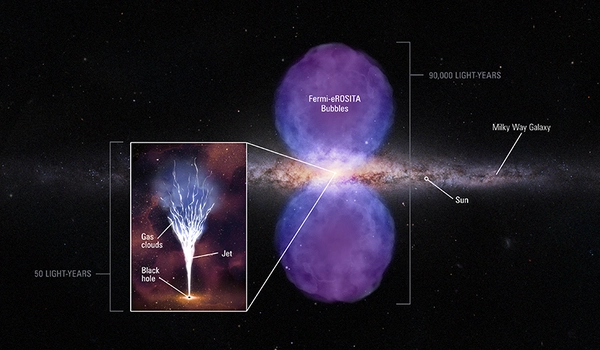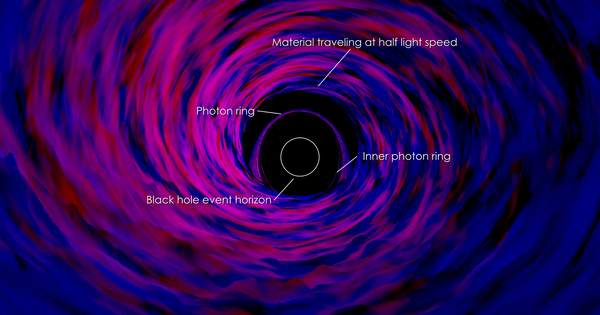Black holes are among the most fascinating and perplexing objects in the universe. The very thing that distinguishes a black hole makes it difficult to study: its extreme gravity. The entire mass of a black hole is concentrated in a small region bounded by a boundary known as the “event horizon.” Nothing, not even light, can cross that boundary and return to the outside universe. A black hole cannot be seen.
NASA Goddard Space Flight Center scientists used the NASA Center for Climate Simulation (NCCS) to run 100 simulations of jets, which are narrow beams of energetic particles that emerge at near-light speed from supermassive black holes. These behemoths sit at the centers of active, star-forming galaxies like our own Milky Way galaxy, and can weigh millions to billions of times the mass of the sun.
Jets and winds emitted by these active galactic nuclei (AGN) “regulate the gas in the center of the galaxy and affect things like the rate of star formation and how the gas mixes with the surrounding galactic environment,” according to study lead Ryan Tanner, a postdoc in NASA Goddard’s X-ray Astrophysics Laboratory.
“We focused our simulations on less-studied, low-luminosity jets and how they influence the evolution of their host galaxies.” Tanner stated. He worked on the computational study with X-ray Astrophysics Laboratory astrophysicist Kimberly Weaver, which was published in The Astronomical Journal.
We focused our simulations on less-studied, low-luminosity jets and how they influence the evolution of their host galaxies. Being able to use NASA supercomputing resources allowed us to explore a much larger parameter space than if we had to use more modest resources.
Ryan Tanner
Radio telescopes were the first to detect jets and other AGN outflows, followed by X-ray telescopes from NASA and the European Space Agency. Astronomers, including Weaver, have pieced together an explanation for their origin over the last 30 to 40 years by connecting optical, radio, ultraviolet, and X-ray observations.
Tanner explained that “high-luminosity jets are easier to find because they create massive structures that can be seen in radio observations. Because low-luminosity jets are difficult to observe, the astronomy community does not understand them as well.”
Enter NASA supercomputer-enabled simulations. For realistic starting conditions, Tanner and Weaver used the total mass of a hypothetical galaxy about the size of the Milky Way. For the gas distribution and other AGN properties, they looked to spiral galaxies such as NGC 1386, NGC 3079, and NGC 4945.

Tanner modified the Athena astrophysical hydrodynamics code to investigate the interactions of jets and gas across 26,000 light-years of space, roughly half the radius of the Milky Way. The team chose 19 simulations from a total of 100 for publication, which consumed 800,000 core hours on the NCCS Discover supercomputer.
Tanner explained, “Being able to use NASA supercomputing resources allowed us to explore a much larger parameter space than if we had to use more modest resources. This resulted in the discovery of important relationships that we would not have discovered with a more limited scope.”
The simulations uncovered two major properties of low-luminosity jets:
- They interact with their host galaxy much more than high-luminosity jets.
- They both affect and are affected by the interstellar medium within the galaxy, leading to a greater variety of shapes than high-luminosity jets.
“We have demonstrated how the AGN impacts its galaxy and generates the physical features, such as shocks in the interstellar medium, that we have observed for about 30 years,” Weaver said. “These findings are consistent with optical and X-ray observations. I was surprised at how well theory matches observations and answers long-standing questions I had about AGN, such as NGC 1386, that I studied as a graduate student! We can now move on to larger samples.”
















